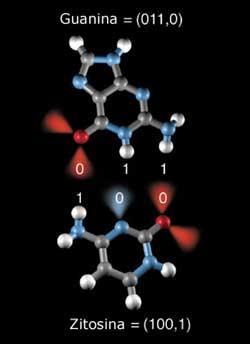Why are DNA bases?
For the body to function properly, it is essential to correctly replicate the genetic code, and for this to be done well it is necessary to have bases without errors. According to the scientist, the chemical composition of the bases contributes to reduce errors in the genetic code.
To demonstrate this, it has compared the chemical characteristics of the bases with the code system used in computing (0 and 1). But before we remember the characteristics of the bases: Adenine (A) and guanine (G) are included in a molecular group called purine. Thymine (T) and Cytosine (C) belong to the pyrimidines group. To form the DNA chain, each purine is associated only with a pyrimidine, A-T and G-C, and the bonds between base pairs are hydrogen.

The scientist has translated all this data into computer language, so that each molecule has its code according to its characteristics. Take G as an example. It is associated with G C by hydrogen bonds. Analyzing the internal structure of the union between the two bases, G corresponds to code 011. (See image)
In addition, purine bases are given value 0 and pyrimidines 1. Thus, the G code will be 011.0. The C code is 100.1. As can be seen, the codes of both bases are perfectly compatible. The same thing happens with A and T.
The codes of the four bases have a very special feature: in the computer language, they form even parietades, that is, the number of 1 that can be found in each code is always even.
If we remove the code from a faulty base, we will see that the number of 1 changes and the total number goes from being even to odd. This greatly facilitates the detection of faulty bases and, consequently, their repair.
For this characteristic, according to Mac Donaill, the fact that the bases that form the genes are these four is not a coincidence, but the result of a long selective selection.
Buletina
Bidali zure helbide elektronikoa eta jaso asteroko buletina zure sarrera-ontzian











